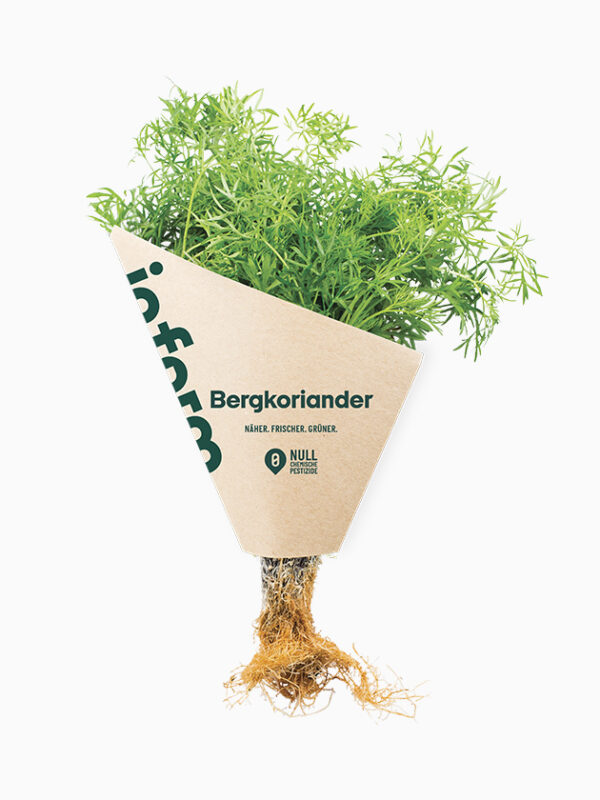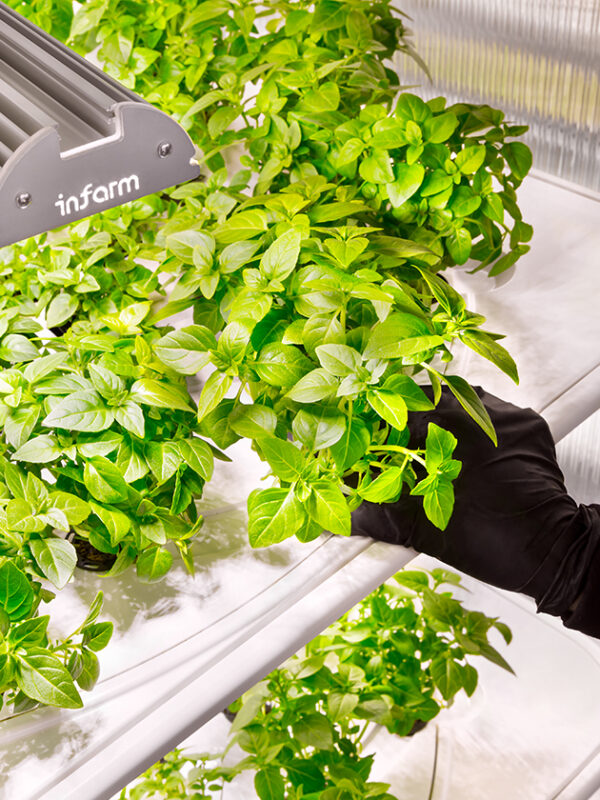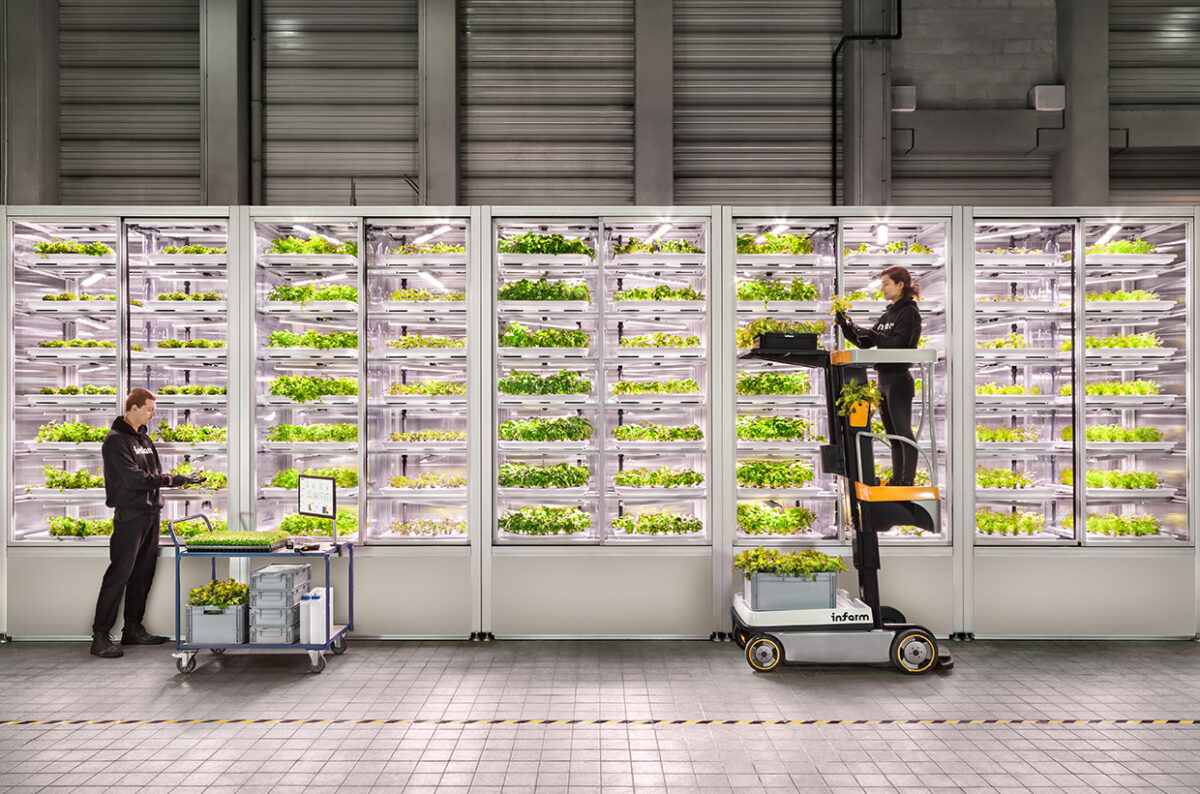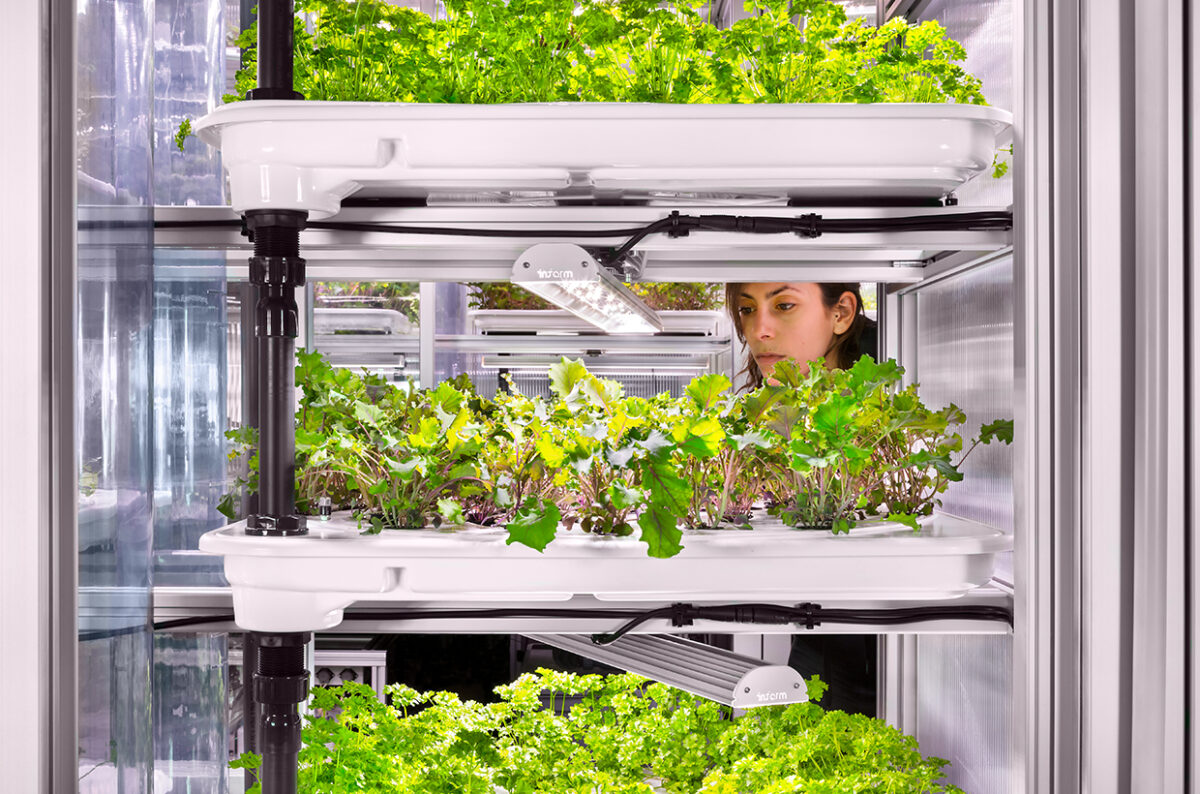Vertical Farming by Silke Bender | 4th March, 2022 | Personalities
This high-tech solution could be the future of food. Investors all around the world are suddenly backing vertical farming, a booming industry that the pandemic has accelerated. The clever idea: growing vegetables on city roofs and in supermarkets and restaurants – right where they’re sold.
First come the strawberries. On the roof of the Paris Trade Fair grounds in the Porte de Versailles neighborhood, gardeners are fanning out under still leaden skies. Their mission: fixing seedlings to tall, white columns reminiscent of vertebrae. Developed right here in France, these aeroponic columns make use of a technique in which the roots hang in the air and are constantly sprayed with a nutrient solution. They require no pesticides and only 10 percent of the usual amount of water in order to thrive. “It all still looks a bit sad now,” says Sophie Hardy. “But by May, at the latest, this will have turned into a lush, green oasis.” Hardy is the director of Nature Urbaine, an urban rooftop farm roughly the size of two soccer pitches – the largest in Europe. If all goes as planned, her farm will eventually produce up to three tons of fruits and vegetables a year that will be supplied directly to local residents, supermarkets, the neighboring Novotel and restaurants like the Le Perchoir, which is located on the same roof. As many as 156 plots are also rented out to private individuals for a year at a time. Unsurprisingly, these “garden plots 2.0” are snapped up quickly each growing season.
“Nobody would stack the books in their library on the floor.” DR. NATE STOREY, CO-FOUNDER AND CHIEF SCIENCE OFFICER OF PLENTY
The pandemic with its disrupted supply chains and partly empty shelves on the one hand, and the climate debate on the other, have created fertile ground for ideas that were still being derided ten years ago. “Our approach – bringing farms into the city and offering fresh, healthy produce with short supply chains – contributes to carbon neutrality and biodiversity. All of a sudden, this makes sense to everyone,” Sophie Hardy says.
The approach taken by Berlin startup Infarm is far removed from this urban agricultural idyl. Infarm grows its fresh greens in futuristic glass cases with rotating strips of LED light. When Good Bank opened its first vertical farm-to-table restaurant in Berlin’s Mitte neighborhood in 2017, passers-by thought the glass cases of sprouting greens were an art installation. Today, the futuristic incubators glow in more and more supermarkets around Germany and shoppers can take home the herbs and lettuces grown in them, complete with their roots. In fact, Infarm now manages more than 1,400 of these mobile vertical farms in eleven countries. With roughly 1,000 employees and additional locations in the U.S., the Netherlands, France and Japan, the Berlin- based company has become a market leader in vertical farming. While Infarm declines to divulge any financial details, it has said that the pandemic alone has boosted its revenue by more than 200 percent. In two rounds of financing, the company was able to secure investments of 270 million dollars in 2020 and 2021 alone.
The hypermodern “growing center” in Berlin’s Spandau district is lightyears away from the refurbished caravan in Berlin’s Kreuzberg neighborhood where the Israeli company founders Guy Galonska, his brother Erez and Erez’ partner Osnat Michaeli conducted their first experiments in 2013. Today, a former washing machine factory now houses one of the 15 production sites in which the different parameters of the “growing recipes” are developed, tested and optimized with the aid of a data-driven approach. Once harvested, the nutritional value, yield and taste of the produce are analyzed to determine the ideal combination of variables. Only then are the plants shipped to supermarkets inside their glass cases as self-contained “farming units.”
Vertical farming seems to have the potential to replace the trend towards organic produce in the food industry. According to a recent study from the U.S., this new market, whose global revenue was already estimated to be 4.3 billion dollars in 2021, looks poised to grow to up to 20 billion dollars by 2028.
Indoor farms are popping up everywhere – a solution not just in times of pandemic. They could also prevent future food insecurity in the face of a human population estimated to rise as high as 9.7 billion by 2050 and increasingly frequent disastrous weather events. “Industrial agriculture is responsible for 17 percent of global carbon emissions. If we produce locally, we can focus on optimizing taste and quality, rather than on extending the shelf-life of a product being transported along the supply chain,” Guy Galonska said in an interview with the KfW investment and development bank. “We produce sustainably: All of our farms use 95 percent less water and 95 percent less soil than traditional agriculture, and we don’t use chemical pesticides. Our aim is to make our production processes carbon neutral.”
If it was up to Dr. Nate Storey of San Francisco- based Plenty, space-saving indoor farms would completely replace traditional farming and greenhouses in the future. The agricultural engineer loves illustrating the advantages of vertical farming: “Nobody would stack the books in their library on the floor,” he once said. This way, “we can give the world back land”: the jungles of Borneo to the orangutans, the Amazon to the planet and the Midwest to the bison.
Plenty’s partially automated farms have mostly been supply leading regional supermarkets in California, Wyoming and Washington State since 2014. Amazon founder Jeff Bezos and other big financiers have so far invested more than 541 million dollars in the company, which is one of the current market leaders in the U.S. today Dr. Storey, however, is thinking much further ahead. He says that if we manage to grow the same nutritious, flavorful plants – sustainably and independent of climate, sun and air – all over the planet, we would also be able to feed ourselves on Mars. So already, the story has come full circle, because the foundations for vertical farming technology were laid at NASA in the 1980s. Its engineers stacked the first rows of hydroponic cases like bookshelves on the walls of a hyperbaric chamber left over from the Mercury space capsule. They wanted to research how to feed astronauts on long space missions.







